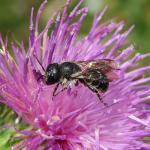Else & Edwards (in press) will cover this species. It has also been covered in several other works, including Banaszak & Romasenko (2001) and Amiet et al. (2004).
In mainland Britain there is a record (attributed as 1850) apparently from either Walmer or Deal in East Kent (Else & Edwards, in press). More recently, two examples from gardens in Leicestershire have been taken by Chris O’Toole (2004 and 2008) at trap-nests. These bees may have been accidentally imported through lorries carrying wooden pallets from the continent (O’Toole pers. comm. in Else & Edwards, in press). Establishment of discrete populations from these apparently imported bees into the local area cannot be ruled out. It is also known from Jersey on the Channel Islands (Richards, 1979).
On the continent it is a widely distributed bee found across much of Europe from Denmark and Germany to Spain, and Turkestan in northern Asia to Syria further south. It is also found in north Africa.
The Channel Islands are, for a number of reasons, excluded from the geographical coverage of the British Red Data book (Shirt, 1987) and the subsequent review (Falk, 1991).
Müller (pers. comm. in Else & Edwards, in press) suggests it is found in similar habitats to the closely related Osmia leaiana (Kirby) with abundant thistles and dead wood. Therefore the bee’s preferences are likely to be flowery, “structured” open habitats or open woodland habitats such as wood pasture with dead wood and pithy-stemmed plants in which to construct a nest.
The two recent mainland examples were taken in early June. Along with other osmiine bees it is likely to be on the wing from late May to late July or later. Else & Edwards (in press) give June to September as the flight period. In Germany it flies from early May to early August, and in Slovenia it flies in June and July (Gogala, 2013). The species is univoltine.
As with other Osmia species and the broader Megachilinae, niveata utilises pre-existing holes and cavities to create a nest. Most often these are old beetle holes in dead wood or broken, dry pithy stems of plants such as bramble and umbellifers. There is a record of it using Arundo (a grass cane) on the continent (Müller, 2013). They will also utilise holes in rocks, stones and masonry cavities. The female bee creates a series of cells within a stem or pre-existing hole. These cells are constructed end-to-end and provisioned with pollen, on which a single egg is laid. The cells are partitioned with chewed-up leaves from plants such as mallow and sage.
As noted above, this bee is oligolectic but feeds on nectar from a wide range of flowers from the family Asteraceae, and also flowers from a range of other families including Brassicaceae, Geraniaceae, Lamiaceae and Boraginaceae.
In Germany, Stelis phaeoptera (Kirby) and S. punctulatissima (Kirby) are known cleptoparasites of Osmia niveata.
2019


